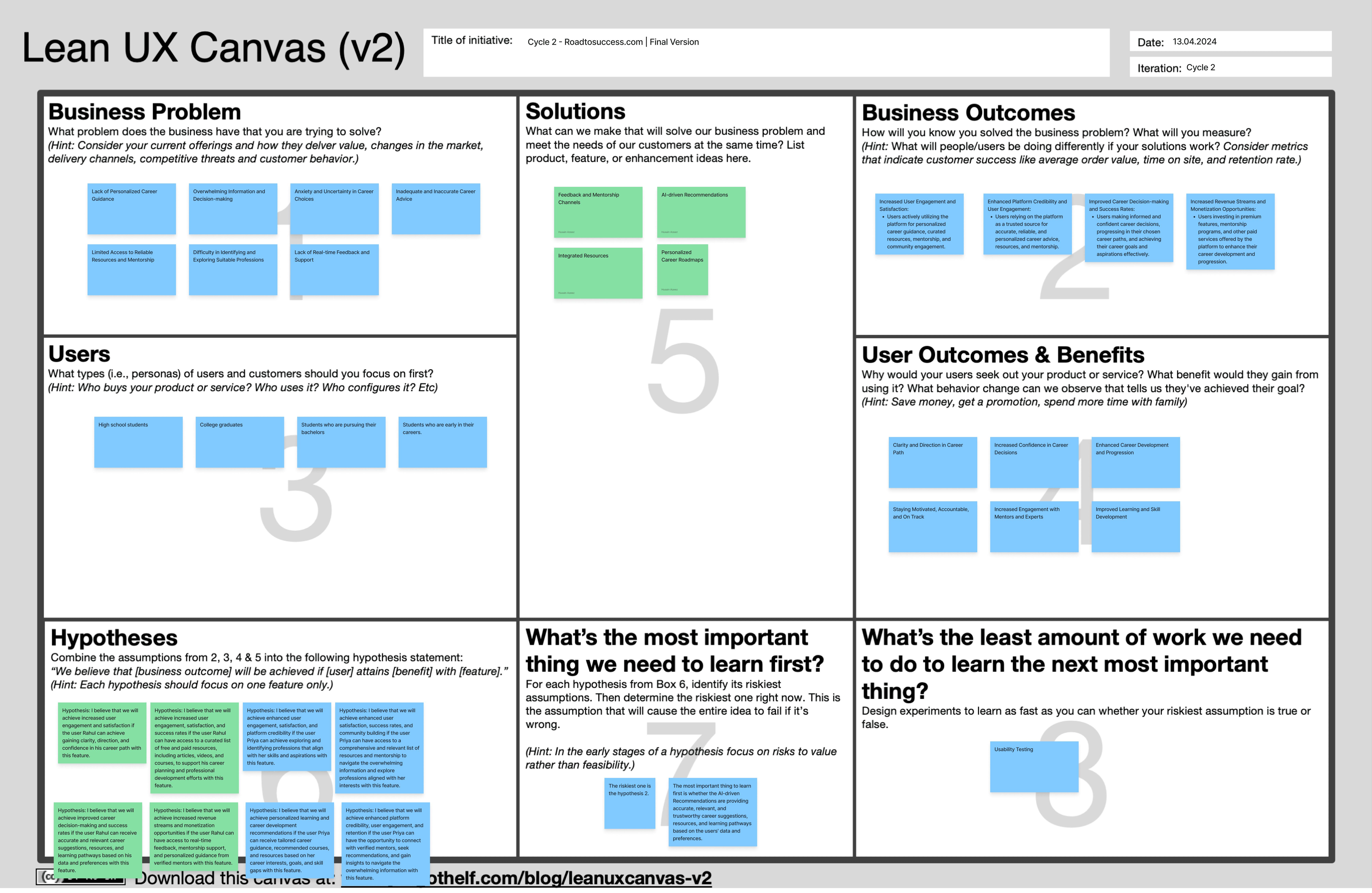High school and graduate students in India often face overwhelming pressure and confusion when choosing a career path. Misinformation, limited awareness, and external pressures exacerbate their anxiety, making it difficult to make informed decisions.
To alleviate these challenges, I set out to develop "Choices - Your Career Compass," a comprehensive career roadmap generator. The objective was to create a tool that provides personalized, realistic career timelines, thereby reducing the stress and fear of missing out (FOMO) associated with career planning.
The goal of this project was to design an Minimal Viable Product of a comprehensive career roadmap generator that could assist students in making informed career decisions.
The success metrics included achieving high user satisfaction, reducing anxiety related to career planning, and validating the app's usability and effectiveness through user feedback. The project followed Lean UX principles, emphasizing rapid hypothesis testing and continuous iteration.
The platform achieved a mean satisfaction score of 96.25% in user testing, validating its effectiveness in addressing the students' needs. Students appreciated the personalized approach and the wealth of resources available.
Students reported reduced anxiety and increased confidence in their career decision-making process. They felt more informed and supported in their journey, which directly addressed the initial problem of confusion and pressure.
The development process actively involved the target audience of diverse students of India by utilising collaborative tools such as Microsoft Teams, Google Sheets, Miro, Trello, and Figma.
Part 1
I conducted extensive primary and secondary research, including user interviews, to understand the pain points and aspirations of students. The insights revealed that students needed a reliable source of career information and a structured way to plan their future.
Based on my findings, I formulated several assumptions about what students need from a career planning tool.
Fig 1: Lean ux canvas - early version.
Fig 2: Assumption Prioritisation.
Part 2
I created proto-personas and journey maps to visualize the students' needs and behaviors. This exercise helped identify critical touchpoints and pain points in their decision-making process. The results highlighted the importance of personalized guidance and easy access to credible resources.
Using techniques like assumption prioritization, MOSCOW analysis, and the Bull's Eye technique, I identified the most impactful elements for users. These techniques revealed that students prioritized features such as personalized career timelines, integration of educational resources, and access to mentor feedback.
Part 3
I began by designing low-fidelity prototypes to quickly test my ideas. These prototypes were shared with students to gather early feedback, ensuring the direction aligned with their needs.
Based on user feedback, I iteratively refined the prototypes. Students expressed a need for clarity and ease of use, which led to simplifying the interface and enhancing guidance through the app.
With refined high-fidelity prototypes, I conducted usability tests. Students found the personalised career timelines and the resource integration particularly valuable, as they provided clear, actionable steps.
Fig 3: Lean ux canvas - Final version.
Part 4
The MVP
Personalized Career Timelines
Tailored roadmaps that align with students' individual goals and circumstances, making it easier for them to plan their future.
Resource Integration
Access to a variety of free and paid resources, such as YouTube videos and articles, which helped students gain the necessary skills and knowledge for their chosen careers.
Verified Information
A database of credible, verified information ensured that students received accurate and trustworthy guidance, reducing misinformation.
Mentor Feedback
A feedback mechanism allowed students to receive guidance and update their progress with input from verified mentors globally, providing a sense of direction and support.
Results
Personalized Career Timelines
Personalized career timelines and resources significantly improved students' understanding of potential career paths.
80% of users reported a better grasp of career options post-interaction with the app.
Reduced Anxiety & FOMO
The app's structured approach to career planning alleviated stress related to decision-making.
75% of users noted a decrease in anxiety about their career future.
Usability, Accessibility & Functionality
Achieved an 85% positive rating on usability from user testing sessions.
Users appreciated the intuitive interface and clear navigation.
78% of users expressed willingness to recommend the app to peers.
Effective Planning and Decision-Making
Users reported improved decision-making due to the app’s detailed guidance and personalized recommendations.
70% of users felt more confident in their career choices after using the app.
Iterative Improvements
Continuous feedback led to several iterations, enhancing the app’s features and addressing user concerns.
Specific improvements included clearer onboarding instructions and more interactive elements in the career roadmap.
Thank you for reading.
work@husainazeez.com
+447776339740
www.husainazeez.com






